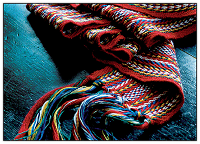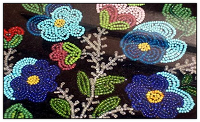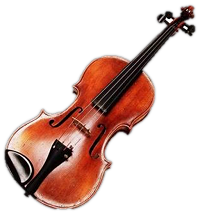SASH
 • Symbol of Métis heritage for more than 300 years.
• Symbol of Métis heritage for more than 300 years.
• Originated during the fur trade period.
The Métis share the sash with two other groups who also claim it as a symbol of nationhood and cultural distinction.
It was worn by eastern woodland Indians as a sign of office in the 19th century, and French Canadians wore it during the Lower Canada Rebellion in 1837.
FLAG
 • Predates the Canadian Flag by 150 years
• Predates the Canadian Flag by 150 years
• It symbolizes both the dawn and destiny of a new Aboriginal group
• Arising from the coming together of two distinct cultures, European and First Nation
• Like the unbroken circles arrayed upon the flag, the Métis people will endure forever
BEADWORK
 • The Métis were famous for their floral beadwork, and were often called the ‘Flower Beadwork People’. The symmetric floral beadwork, often set against a black or dark blue background, was inspired by European floral designs. They used seed beads
• The Métis were famous for their floral beadwork, and were often called the ‘Flower Beadwork People’. The symmetric floral beadwork, often set against a black or dark blue background, was inspired by European floral designs. They used seed beads
Beadwork was added to: • Jackets • Bags • Leggings • Gloves • Vests • Pouches
VOYAGEUR CANOE
 • Traditional voyageur canoes were large birch-bark canoes built for the fur trade business
• Traditional voyageur canoes were large birch-bark canoes built for the fur trade business
• Capable of carrying 12 to 20 passengers and 1,400 kilograms (3,100 lb.) of cargo
• The two common sizes were the 36' long Montreal canoe for use on the Great Lakes and the 26' long North Canoe used on the interior rivers
FIDDLE MUSIC AND DANCE
 • Métis style fiddle music is an oral tradition handed down for many centuries
• Métis style fiddle music is an oral tradition handed down for many centuries
• The fiddle plays the melody, tells the story
• Rhythm is supplied by toe tapping or spoons
• The uneven and irregular beats of the fiddle creates a bounce in Metis jigging that is as unique as the fiddling itself
• The extra beats make the Metis jig a rapid moving dance and though similar to the Scots - Irish step dance, the Metis jig is unique in style